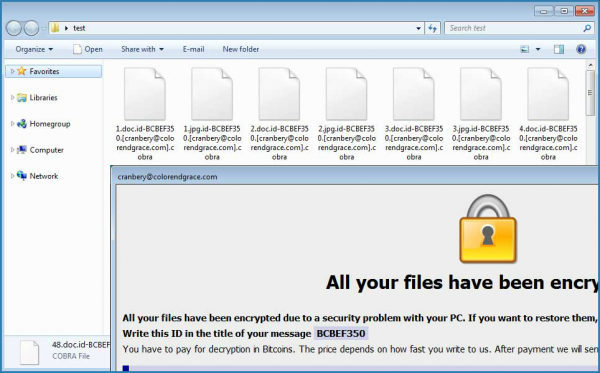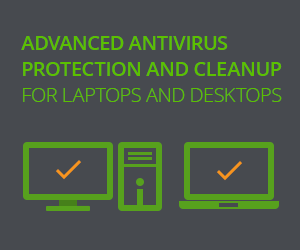Security researchers from the ID-Ransomware project have found a new version of the Dharma – Crysis Ransomware this week. This new variant creates the .cobra extension to all locked files.

For now, it is not clear how this version is being spread. In the past Dharma – Crysis was distributed by penetrating the Remote Desktop Service (RDP) and installing the virus manually.
Once the Cobra ransomware version gets installed, it scans your PC for various data files and immediately start to encrypt those.
After encryption is over, ransomware will add an extension that looks like this: .id-(id).(email).cobra. For instance, a file called mypicture.jpg will be locked and named like mypicture.jpg.id-BABD201.([email protected]).cobra.
It is important to note this extortion virus may encrypt also mapped network drives together with all unmapped network shares.
Possible victims should ensure their network’s shares are closed for unauthorized access and only those with necessary permissions may have access.
Once .cobra version encrypts a PC, it is going to remove all shadow volume copes on the computer and they cannot be utilized to restore files. It removes them using the following command: vssadmin delete shadows/all/quiet.
Cobra virus will then create 2 different ransom messages (notes) on the infected the machine. One of them is an info.hta file. Criminals use an autorun function to launch it when a victim logs into the PC. Another note is named Files encrypted!!.txt. It located on the desktop. Both ransom notes request to email [email protected] to receive further payment instructions.
Finally, the Cobra ransomware configures itself to start automatically when victims login to Windows system. This option enables it to lock all new files that were created after it was initially executed.
One of the ways to restore encrypted files is by using backups or through Shadow Volume Copies.
Although Dharma – Crysis attempts to delete the Shadow Volume Copies, in some cases virus fails to do it because of various technical glitches. Some other ways to recover files are listed below in our guide.
Automatic removal of .cobra File Virus
The benefits of using the automatic security suite to get rid of this infection are obvious: it scans the entire system and detects all potential fragments of the virus, so you are a few mouse clicks away from a complete fix.
- Download and install recommended malware security suite
- Select Start Computer Scan feature and wait until the utility comes up with the scan report. Proceed by clicking on the Fix Threats button, which will trigger a thorough removal process to address all the malware issues compromising your computer and your privacy.
Restore files locked by .cobra File Virus
new Locky variant aka .cobra File Virus represents a unique category of malicious software whose attack surface reaches beyond the operating system and its components, which is why removing the virus itself is a part of the fix only. As it has been mentioned, it encrypts one’s personal information, so the next phase of the overall remediation presupposes reinstating the files that will otherwise remain inaccessible.
-
Launch data recovery software
Similarly to the rest of its fellow-infections, .cobra File Virus most likely follows an operational algorithm where it erases the original versions of the victim’s files and actually encrypts their copies. This peculiarity might make your day, because forensics-focused applications like Data Recovery Pro are capable of restoring the information that has been removed. As the virus further evolves, its modus operandi may be altered – in the meanwhile, go ahead and try this.
-
Take advantage of Volume Shadow Copy Service
This technique is based on using the native backup functionality that’s shipped with Windows operating system. Also referred to as Volume Snapshot Service (VSS), this feature makes regular backups of the user’s files and keeps their most recent versions as long as System Restore is on. Cobra File Virus ransomware hasn’t been found to affect these copies therefore the restoration vector in question is strongly recommended. The two sub-sections below highlight the automatic and manual workflow.
- a) Use Shadow Explorer
Shadow Explorer is an applet that provides an easy way of retrieving previous versions of files and folders. Its pro’s include an intuitive interface where the computer’s entire file hierarchy is displayed within one window. Just pick the hard disk volume, select the object or directory to be restored, right-click on it and choose Export. Follow the app’s prompts to get the job done.

- b) Use file properties
Essentially, what the above-mentioned Shadow Explorer tool does is it automates the process that can otherwise be performed manually via the Properties dialog for individual files. This particular approach is more cumbrous but just as effective as its software-based counterpart, so you can proceed by right-clicking on a specific file, which has been encrypted by Cobra File Virus, and selecting Properties in the context menu. The tab named Previous Versions is the next thing to click – it displays available versions of the file by date of the snapshot creation. Pick the latest copy and complete the retrieval by following the prompts.

-
Data backups work wonders
Ransomware like Cobra File Virus isn’t nearly as almighty and destructive in case you run regular file backups to the cloud or external data media. The virus itself can be completely removed in a matter of minutes, and the distorted information can then be just as easily recovered from the backup. Luckily, this is a growing trend, so ransom Trojans are hopefully going to become less subversive in the near future.
Verify thoroughness of the removal
Having carried out the instructions above, add a finishing touch to the security procedure by running an additional computer scan to check for residual malware activity
